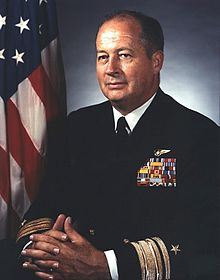Forrest S. Petersen
Forrest Silas Petersen (born May 16, 1922 in Holdrege , Nebraska , † December 8, 1990 in Georgetown , South Carolina ) was an American test pilot .
Career
Petersen graduated from the United States Naval Academy with a marine science degree in 1944 and was posted to the destroyer USS Caperton as a lieutenant . During his time on board the destroyer, he took part in missions in the Philippines , Taiwan and Okinawa . After completing flight training, he was posted to Strike Fighter Squadron 192 in 1947 .
Petersen studied at the Naval Postgraduate School, where he obtained a Bachelor of Science degree in aerospace engineering in July 1950 . He continued his studies at Princeton University , where he received a Master of Science degree in engineering . From 1953 to 1956 he served in Fighter Squadron 51 . In 1956 he was posted to the United States Naval Test Pilot School and remained there as a flight instructor .
In August 1958 he was assigned as a test pilot to the X-15 program and served until January 1962 at what is now the Neil A. Armstrong Flight Research Center at Edwards Air Force Base , California. During this time he undertook five test flights with the X-15 and reached speeds of up to 5800 km / h (Mach 5.3) and altitudes of up to 31 km; he was the only naval aviator. In July 1962 he received the Collier Trophy from President John F. Kennedy and the NASA Distinguished Service Medal from Vice President Lyndon B. Johnson .
Petersen was the commanding officer of Strike Fighter Squadron 154 until he was appointed to the United States Atomic Energy Commission . He was Deputy Commander of the USS Enterprise from January 1964 to April 1966 and received the Bronze Star Medal for the USS Enterprise's first combat mission in Vietnam. In November 1967 he became the commandant of the USS Bexar in the Pacific Fleet . After an eight-month deployment with the 7th US Fleet in the Western Pacific, he received the Navy Commendation Medal with Combat V. He then became the commanding officer of the USS Enterprise (July 8, 1969 to December 3, 1971). After that command, he became Assistant to the Director of Naval Program Planning in the Chief of Naval Operations' office . In 1974 he became commander of the United States Sixth Fleet in Athens. In 1975 he headed the Naval Air Operations Office at the Pentagon . Most recently, he was Vice Admiral in charge of Naval Air Systems Command . He retired from active service in 1980.
family
Petersen was married twice and had three children from his first and one from his second marriage.
Awards
For his services in World War II, the Korean War and the Vietnam War, he received the following medals and badges of honor: Legion of Merit , Distinguished Flying Cross , Bronze Star Medal , Navy Commendation Medal (with "Combat V"), American Defense Service Medal, Asiatic-Pacific Campaign Medal , American Campaign Medal , China Service Medal , Army of Occupation Medal with "Japan" wing, Philippine Liberation Medal, Philippine Presidential Unit Citation, World War II Victory Medal , Korean Service Medal , United Nations Service Medal, Vietnam Service Medal , Vietnam Campaign Medal, National Defense Service Medal with Bronze Service Star, Korean War Service Medal, and the NASA Distinguished Service Medal . In 1962 he received the John J. Montgomery Prize .
death
He died of a brain tumor and was buried in Arlington National Cemetery .
literature
- Milton O. Thompson: At The Edge Of Space: The X-15 Flight Program . Smithsonian Institution Press, Washington and London 1992, ISBN 1-56098-107-5 .
Individual evidence
- ↑ NASA: X-15 Test Pilots. March 1, 2006, accessed January 2, 2019 .
- ↑ George W. Fetherman: Task Force Sixty. Accessed January 2, 2019 .
| personal data | |
|---|---|
| SURNAME | Petersen, Forrest S. |
| ALTERNATIVE NAMES | Petersen, Forrest Silas (full name) |
| BRIEF DESCRIPTION | American test pilot |
| DATE OF BIRTH | May 16, 1922 |
| PLACE OF BIRTH | Holdrege , Nebraska |
| DATE OF DEATH | December 8, 1990 |
| Place of death | Georgetown , South Carolina |
